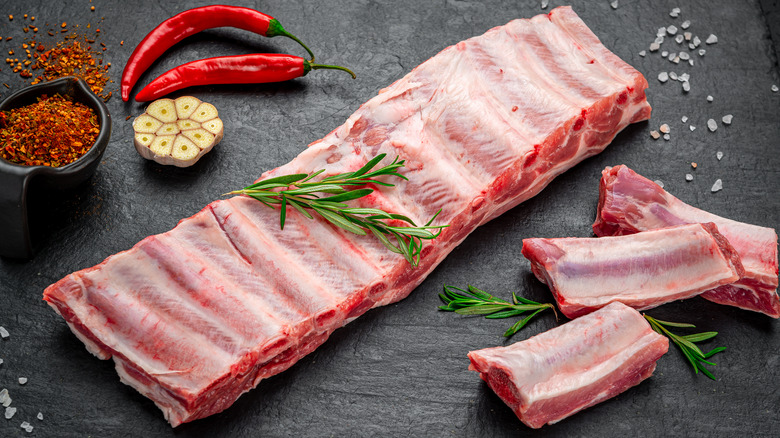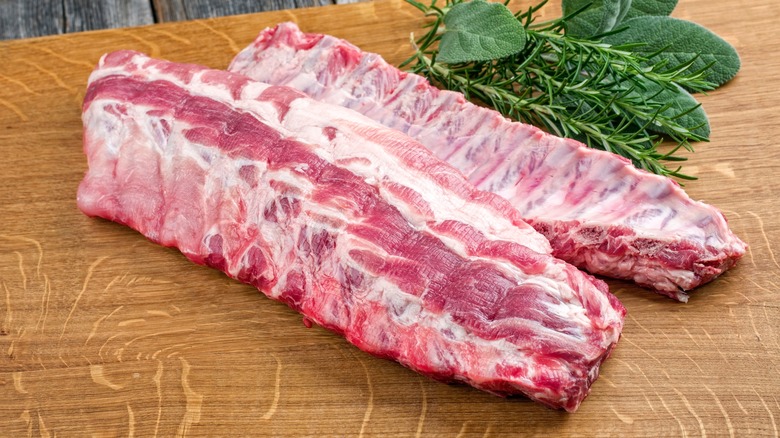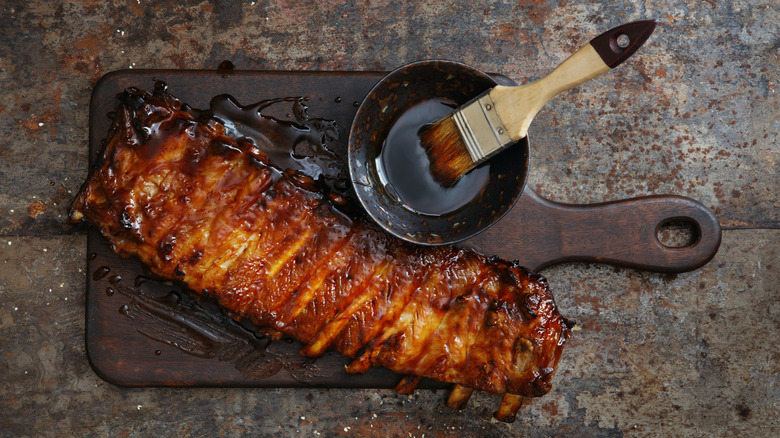The Knife Tip That Will Help You Effortlessly Remove The Membrane From Ribs
Preparing a rack of ribs for the smoker or a low and slow trip in the oven is relatively straightforward. However, if you've ever struggled to remove that shiny, stubborn membrane at the back of the ribs, you wouldn't be alone. It's slippery, it's unappetizing, and can ruin a rack of ribs, so it needs to come off. But if you've got a butter knife within reach, it'll make removing it so much easier.
Any knife with a rounded head will do. Find an entry point underneath the membrane; usually right along the rib bone. A sharper knife would cut the membrane, making it more difficult to remove. The knife will slide under, and then lift the knife, using the ribs as leverage. The skin will come up and you can grab it and pull in one long, steady motion. If it's too slippery to use just your hand, using a paper towel will give you enough grip to pull the skin away. If the skin rips, find another section and repeat the action. After the membrane is removed, you can season your ribs as you usually would.
The silver skin membrane doesn't render and is unpleasantly chewy
What you're removing is the thin, white membrane on the back side — the less meaty side — of the rack of ribs. It's called the peritoneum which acts as a barrier for all the organs in the chest cavity of any animal. It's not cartilage or fat, things on a rack of ribs that usually render when cooked low and slow. It's made of elastin, which won't render in the heat of the grill or oven. After you've removed the membrane, you'll notice how much it shrinks and you'll wonder how it fit on the ribs in the first place.
Back ribs will have a thicker membrane than spare ribs due to their location on the pig or cow. The silver skin on a rack of baby back ribs is thinner than what's found on beef ribs and is generally easier to remove. However, using the butter knife trick will make it easier remove the silver skin on both racks of ribs.
Removing the silver skin comes down to the chef's choice
Usually, one of the first steps for making a great rack of ribs is to remove the silver skin. Not only does it not render, it prevents the meat from absorbing the flavors of a spicy-salty-smokey-sweet spice blend, so you're doing your ribs a disservice. And, after it's cooked, the silver skin is a tough texture and isn't the best thing to bite into when you're expecting tender, fall-off-the-bone ribs. Leaving the skin on can leave the ribs chewy instead of tender, and while you could cook the ribs with the silver skin on and pull it off later, you could pull some of the meat off the bone with it.
You don't have to remove the silver skin, though. Some chefs prefer to keep it on the ribs. According to food reporter Tim Carman at The Washington Post, leaving the silver skin on resulted in a rack of ribs that was more tender and moist than the rack of ribs without the silver skin, but both racks were evenly seasoned throughout. The hypothesis put forth by Carman is that perhaps keeping the silver skin intact prevented too much moisture from escaping during the low and slow cook.
So really, it's up to you, the home cook, if you leave the silver skin on your next rack of ribs or remove it. But make sure to remember this rounded knife tip if you do remove it.


